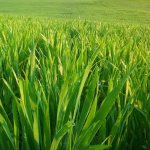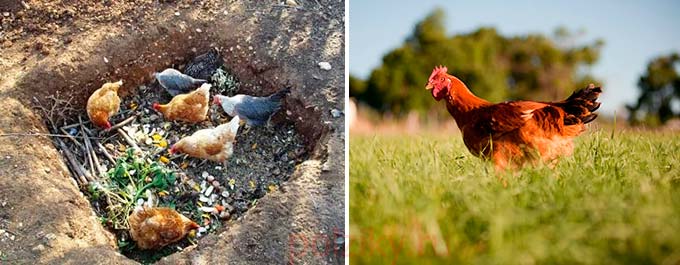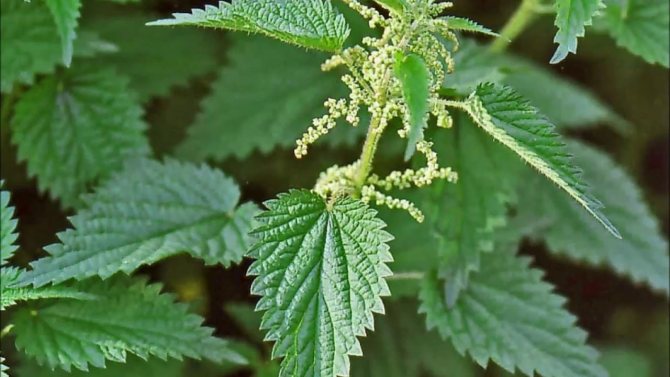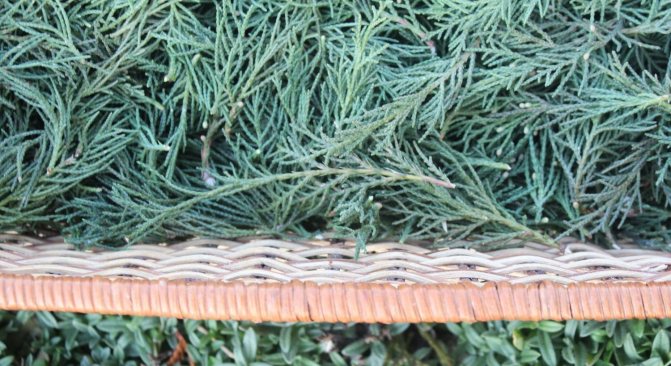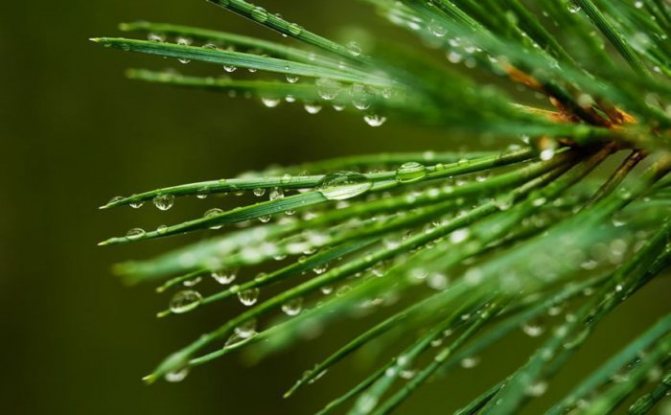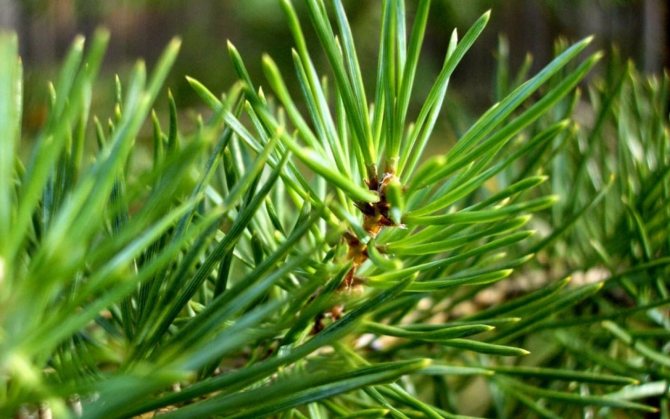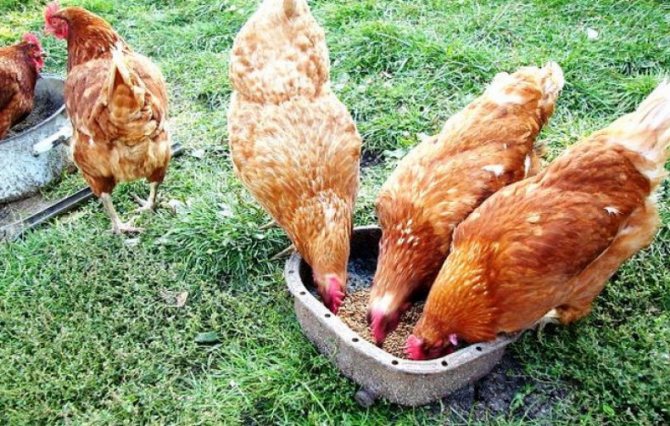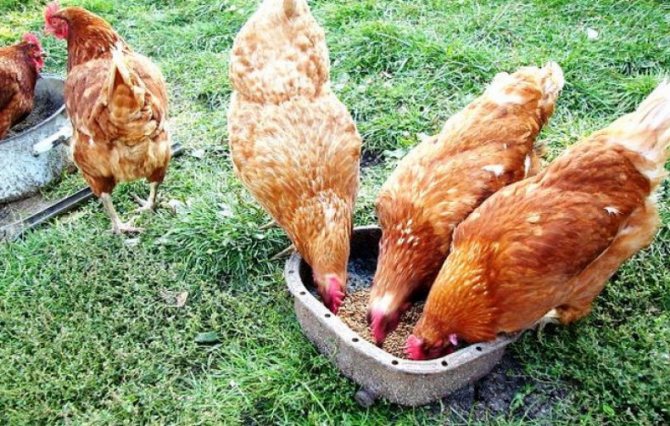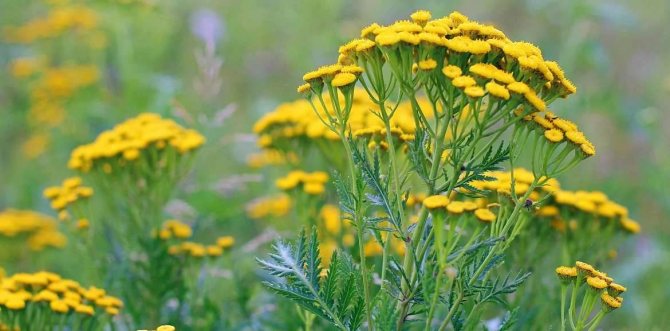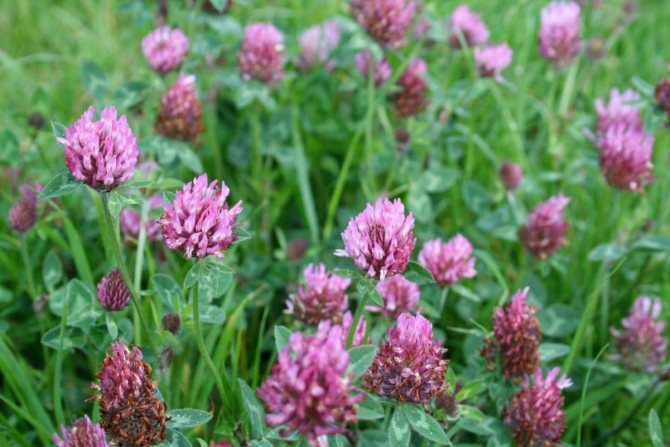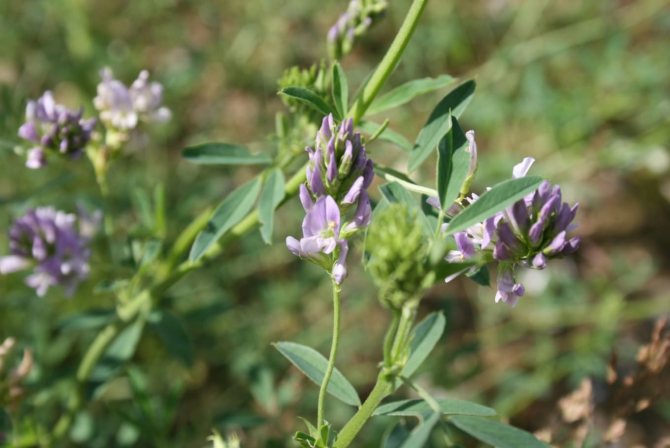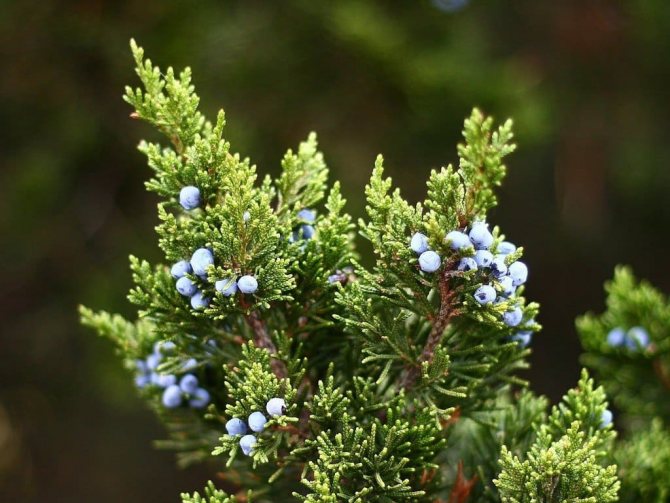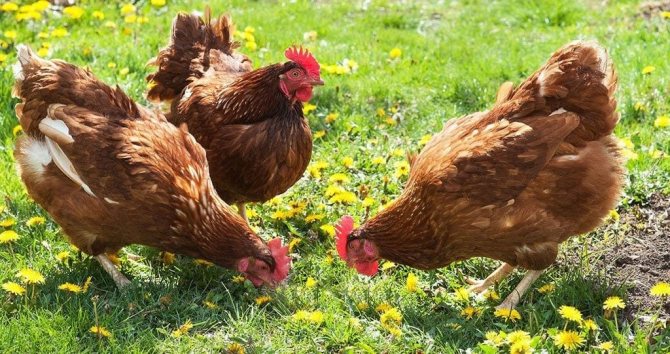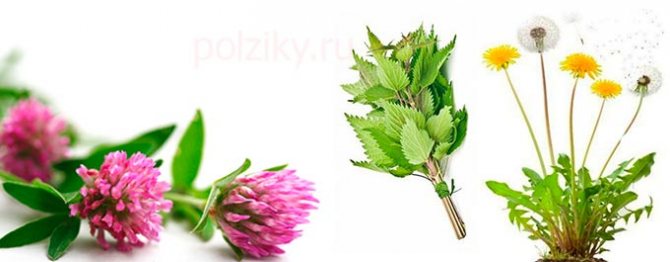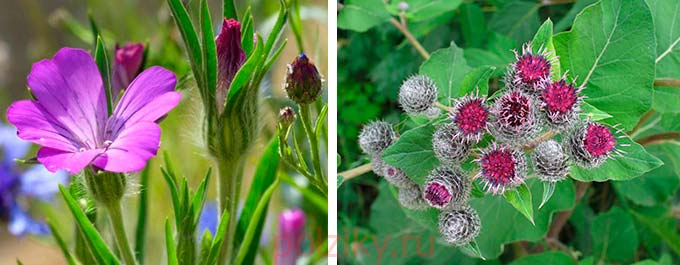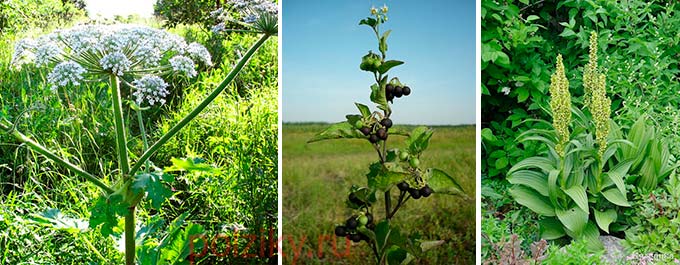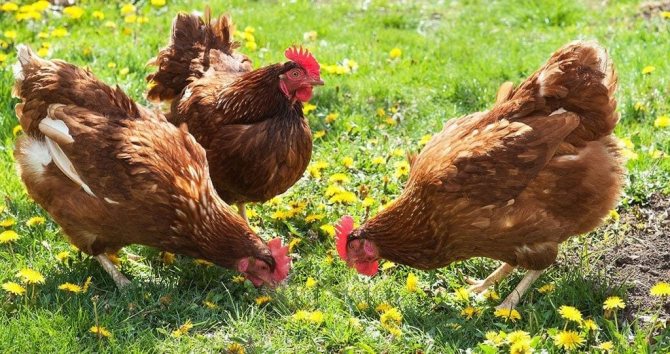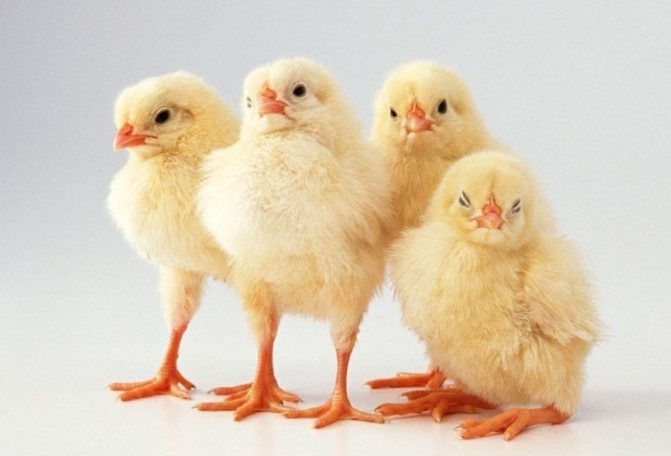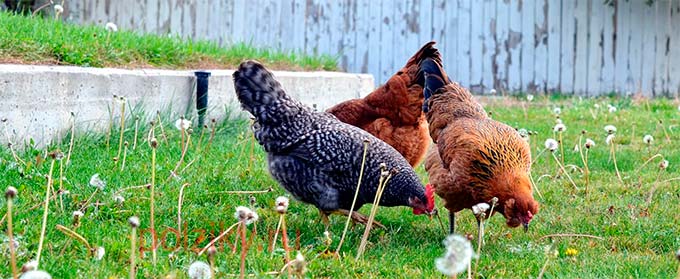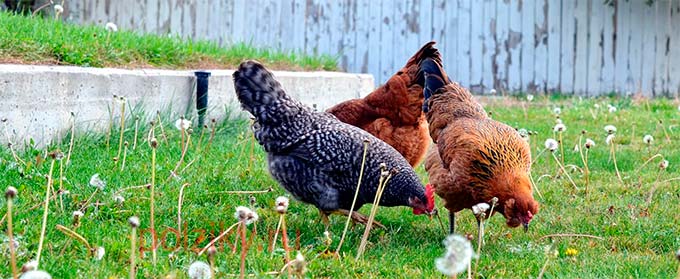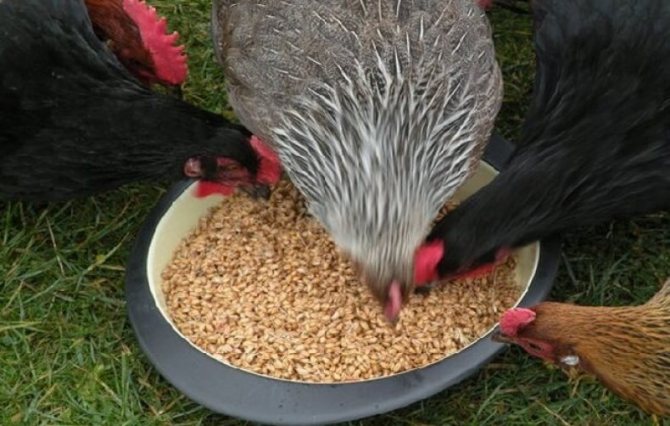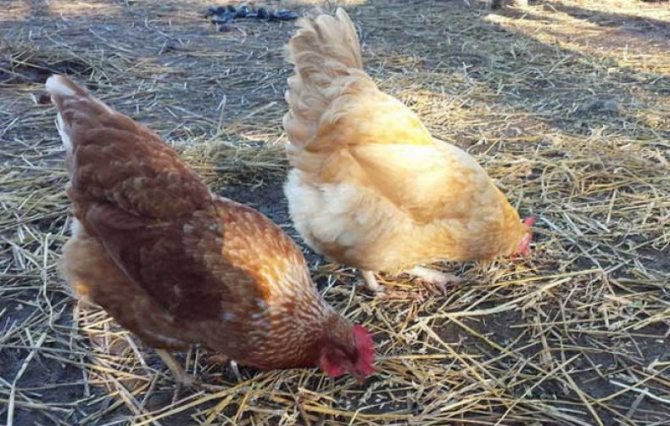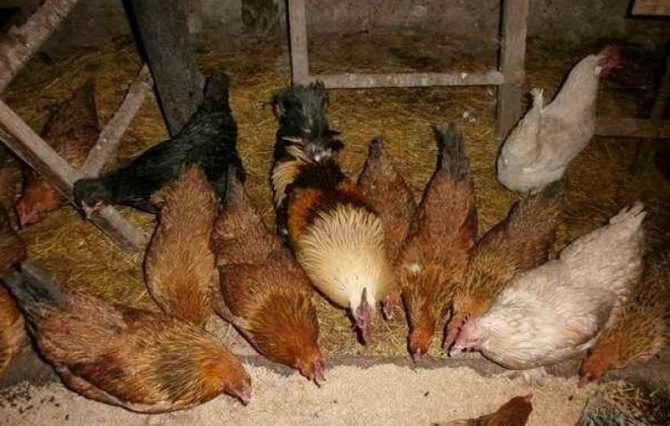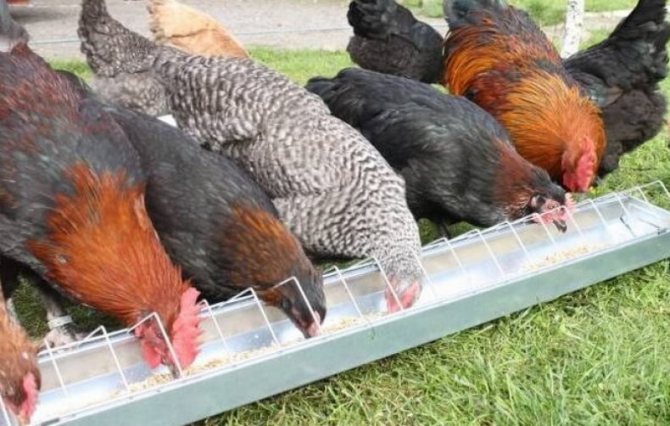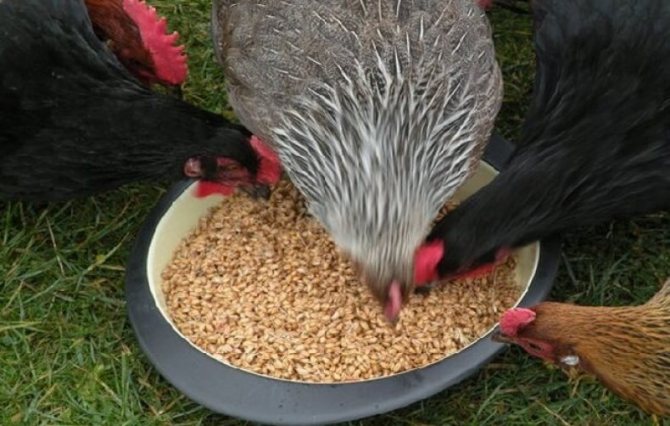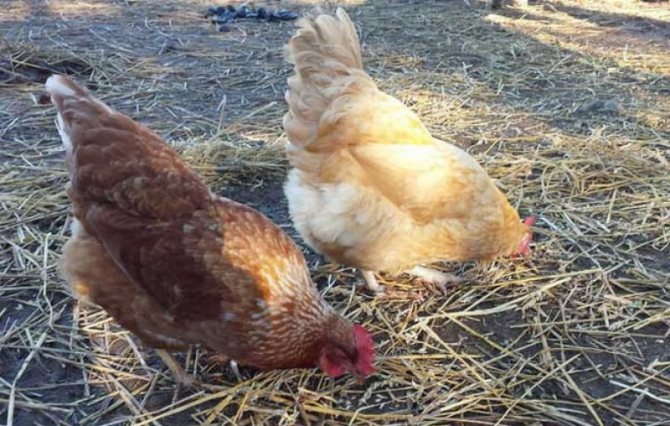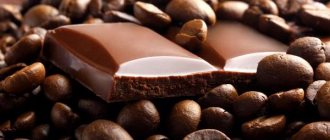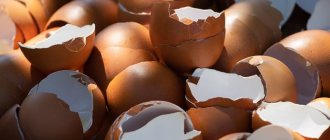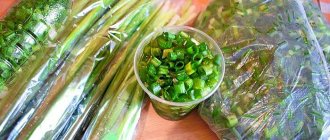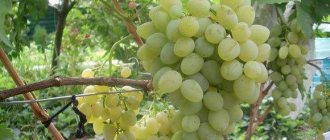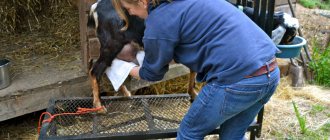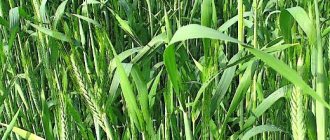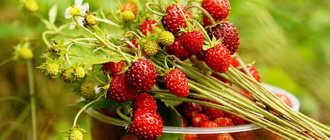205
no comments yet
0
The author of the article
Rasskazov Pavel
Reading time: 4 minutes
The benefits of fresh vegetation are undeniable. Plants contain a large amount of vitamins, minerals and proteins necessary for the full growth, development and strengthening of the immunity of babies.
In winter, grass or flour from harvested hay replaces fresh summer shoots with birds, replenishing the body's needs for essential nutrients. Greens also help to cope with ailments and prevent various kinds of diseases.
Greens in the diet of chickens: benefits
The diet of poultry is made up of grains, vegetables and herbs, especially in the summer, when there is enough of it. In winter, the treat is given in the form of hay or grass meal. Plants contain many vitamins, which in a short time raise the hemoglobin of birds and increase immunity. In summer, green fodder accounts for 50% of the total diet, but only permitted types of herbs can be given so as not to harm the livestock.
While walking, chickens eat plants, therefore, poultry is more valued in cooking than factory poultry, its meat is much tastier, juicier and more tender, and in eggs the yolks are orange, which speaks of greater benefits and nutritional value. Greens have a beneficial effect on the immune, digestive, circulatory systems, increase the productivity of layers, accelerate the growth of young stock, and some herbs even serve as the prevention of diseases and parasites.
What grass can be given to chickens?
The basis of the green diet is vegetable tops and weeds from the garden, freshly cut grass is also used, but in this case they monitor the presence of poisonous species that fall into the forbs. It is best to give grains and legumes:
Alfalfa and clover have useful properties, they can be sown directly in the walking enclosure as a lawn, then the birds will receive greens from the first days of spring. Sorrel and nettle do not stand aside (it is scalded with boiling water), they are rich in vitamin C. Amaranth and spicy herbs strengthen the body as a whole.
Chickens love these herbs:
Alfalfa strengthens the vision of birds, sprouted wheat improves egg production by nourishing the body with vitamin E, and yarrow and tansy are the best remedies for helminths. For good health, chickens are given quinoa, horse sorrel, pine needles, wood lice, euphorbia, garden crops, as well as aromatic herbs (parsley, dill, onion feathers, beet and carrot tops).
Forbidden herbs
Poultry loves all the greens, so the weeds removed from the garden do not have to be thrown away, they can be tied to the hedge in a bunch, and the chickens will be happy to pinch off the leaves. If there is an overgrown meadow on the site, the birds are released for free walking, but in this case it is important to make sure that no poisonous herbs grow there, such as:
- juniper;
- cockle;
- cicuta;
- belladonna;
- spotted hemlock;
- nightshade;
- flowering potatoes;
- elder;
- hellebore;
- henbane;
- broom.
Also, do not give pear and acacia leaves, these plants cause stomach diseases, intestinal upset and can even lead to the death of livestock. Avoid them and carefully look at the grass cut in the field. You can also sow a small plot of land with cereals or alfalfa.
Germination technique
Even beginners who try themselves for the first time in terms of raising chickens will easily cope with the task of germinating grain. This does not require special skills or special tools.
Stage number 1: choose wheat
When buying grain at the market or in a specialized store, check it for quality. It should be free of impurities and have a golden, dark or light brown color. Feed wheat is more commonly used due to its cheap cost, but many farmers do not skimp on high quality material.
Stage number 2: soaking the grain
Before soaking, the product must be rinsed to get rid of dirt. The floating husk must be removed. The process should be carried out in a deep container so that water does not overflow. Use a bucket, basin, plastic tub, or bottle by cutting out the hole you want.
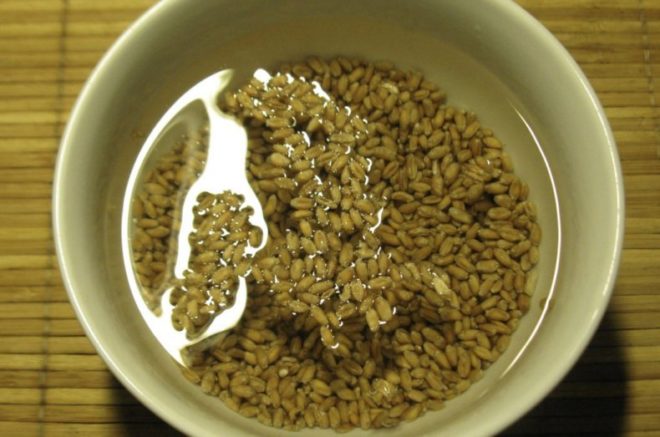
The selected container is thoroughly washed, it is advisable to use potassium permanganate, otherwise there is a risk of bringing in a fungus that will render the grains unusable. Do not use metal utensils - the metal draws out all the substances that are beneficial.
Pour water over the wheat. If it was stored in a warm room, the temperature of the liquid should be +45 degrees. When the starting material is cold, use hotter water for heat shock awakening. But as a result, the temperature should remain at +45.
Stage number 3: holding the resulting mixture
We remove the prepared composition in a warm and dark place. Cover with a lid and leave for 15 hours.
Stage number 4: spread the grains
We take out the wheat from the dishes and, having spread the oilcloth in a room where there is no cold, drafts and bright sunlight, we spread it in a thin layer to avoid decay. Cover with a natural cloth dipped in warm water without bleach.
Stage 5: giving wheat to the birds
After two days, sprouts will hatch. Experts are advised to wait another day for long shoots to appear, but this is not necessary. Our product is ready for feeding birds.
There are other cooking options as well. In the evening, they pour the grain with liquid, and in the morning they put it in a linen bag, putting it in a bowl to drain the water. After that, having closed it tightly, keeping the darkness, leave in a cool place. The next day sprouts will appear and you can start feeding.
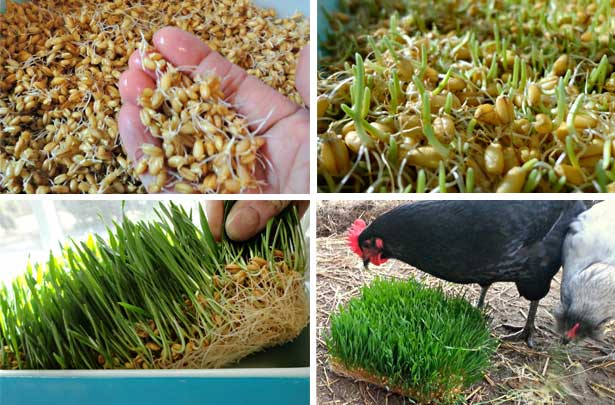

The next method suggests soaking the grains for a day, then transferring them to a voluminous pot with opaque walls, at the bottom of which there are holes. After covering the bottom with paper napkins, install it, ensuring a free drain of water. Cover with a dark cloth. Open and water the sprouts daily. This method will provide both rinsing and moisturizing. You will receive the finished product in 2-3 days.
IMPORTANT! Nuno to know that wheat cannot stay soaked for more than three days. Violation of this rule leads to the danger of the appearance of infectious processes in the intestines in pets, which will lead to death.
It is noted that sprouts, 5 mm in length, add vitamin A to the chicken diet, in order to speed up this process, expose the dishes to the sun. When the shoots reach 6 mm, you can cut them off and give the birds for food, then cover the grain again with a damp cloth. Thus, you will get an enhanced feed from tasty and healthy grains that have sprouted a second time.
Don't get carried away with a large amount of wheat. Sprouted material is not stored for long, so as not to lose precious sprouts, take as much wheat as is enough for several feedings. Grain consumption is calculated to be approximately 20 grams per individual. 10 chickens will need 200 grams per serving, which is a full handful of the product.
Long shoots are difficult to peck up by birds, so you need to crush them using a regular knife. This should be done especially by feeding the sprouts for food to chickens, which gag, swallowing large chunks.
Grass feeding chickens
The choice of grass for young animals is taken even more seriously, because a weak organism is not able to fight poisonous plant juices and reacts more sharply. Fresh greens are finely chopped, mixed with feed or cottage cheese and given to chicks. The product is introduced from the first days of life of chickens, but only from the list of permitted species.
The method of hatching and the type of breed also affects complementary foods, for hatching broilers it is worth waiting a week until their stomachs are strong. Laying hens born with the help of a hen have a stronger immunity, therefore they are ready to peck the mother's feed a couple of hours after hatching, it is important to monitor the cleanliness and diet.
The collected greens are thoroughly washed, dried and chopped in a blender or cut with a knife, after which they are mixed with food, and for an older age they are hung in bunches to the wall of the box.
At what age can greens be introduced into the diet?
In the first week, the chicks are given finely chopped onion feathers or dill; these products have a beneficial effect on the stomach and digestive system. Onions serve as prevention of infections, and dill relieves spasms and colic in the intestines.
Important! The broilers are fed grass 5 days after birth.
From the first to the seventh day of life, 1 gram of greens per individual is enough for chickens, with each subsequent week the amount increases by 3 grams. The general rate of grass by age is:
- 7-10 days - 3 g;
- up to 20 days, 7 g;
- 1 month - 10 g;
- 1.5 months - 15 g;
- 2 months - 17–20 g.
For disinfection, the grass is poured over with boiling water or thoroughly washed with running water, it is better not to give a sluggish and dried one, there are few vitamins and juices left in it.
Plants allowed for young growth
Chickens digest the delicate leaves of dill, young onions, dandelions, scalded nettles, young lettuce or sorrel most easily. It is allowed to give sprouted wheat, chopped plantain, parsley. In winter, they give dried grass, which is crushed and mixed with wet food, here it is important to prevent large and sharp parts of the shoots from entering, which will damage the mucous membrane of the babies.
Important! Clover and alfalfa will be useful for the first feeding, they contain the maximum amount of vitamins and protein that stimulate growth and muscle gain.
Keeping hens healthy
In cases where the farmer completely refuses to walk birds, grasses intended for feeding should be hung in an aviary or on a high feeder, instead of leaving them on the floor.
A feeder made at a certain height will be a good idea for active body movements of chickens.
The thing is that without walking, birds become prone to obesity and the development of certain diseases, and a grass bunch fixed at a height of 1–1.5 m will force the chickens to do a little warm-up when eating. Give the chickens additional movement in this way.
Do not forget that herbal food is used as a medicine in the treatment of diseases of domestic chickens.
For example, yarrow will help protect birds from worms. Greens are widely used in the prevention of a wide variety of ailments, which makes them an even more popular type of feed. So the bird, first of all, can be given herb with medicinal properties, and only then the rest of the plants.
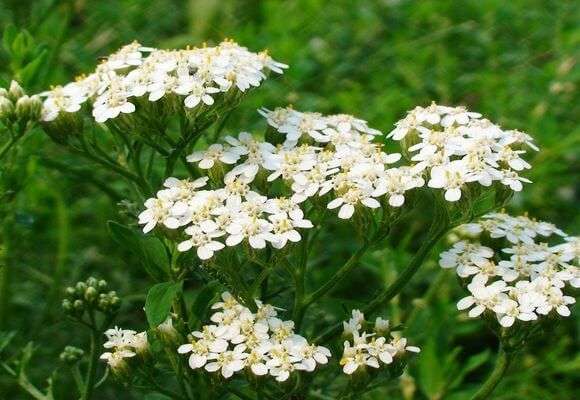

Note that any grass for chickens and adults must be thoroughly washed before serving so that the pets eat a fresh and high-quality green product.
In order to competently raise and feed a healthy farm, a breeder must know exactly at what age, what and how to feed the chickens.
Poultry Assistant - Grass Chopper
To make life easier for farmers, caring producers have released a miracle machine - a shredder, or a garden shredder of grass and branches. The units come in different sizes, capacities and are adapted for any type of processing.Some chop only grass, others turn large branches into sawdust, and still others are versatile and adapted for both functions.
Such a device is simply irreplaceable for a personal plot, the collected weeds are passed through a drum and a loose gruel is obtained, which is given to chickens, dried for the winter or sent to a compost pit for fertilization. With the help of a shredder, it is easy to grind pine shoots and needles at any time of the year, the main thing is to stock up on raw materials.
Important! The herb for chickens is extremely useful, it serves as the best source of vitamins and minerals, and the needles are a medicine and prevention of colds.
Green food plays an important role in the life of birds, so it is worth making preparations in advance. For these purposes, a garden weed, wheatgrass growing nearby and specially grown cereals are suitable. To make the products easier to store and mix in food, poultry farmers recommend chopping them before drying, and then pouring them into bags.
Proper feeding is an essential part of caring for chickens. Only if you give the chicken high-quality and balanced feed, you can get large and quality eggs. From the article we learn what kind of grass can be given to chickens, chickens, so that they are healthy, run well and not get sick.
How to soak and germinate?
Germinating grain is a simple process. To germinate a cereal, it is worth following a certain sequence of actions:
- Take a plastic container and place pure natural material in it.
- Moisten the cloth and place the grains on it.
- Cover with a damp cloth.
- Place the container in a warm and well-lit place.
- The grains should be moistened as needed. This is done before the shoots form.
- When roots and green shoots appear, feed can be given to chickens.
There is also a method for steaming the beans. To do this, follow these steps:
- bring water to a boil;
- put a maximum of 5 grams of salt in it;
- pour boiling water over the cereal;
- boil for 10 minutes;
- drain the water;
- dry the grains.
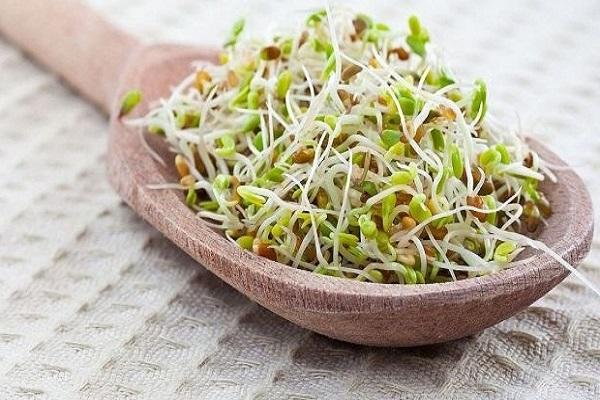

Feeding chickens
Poultry farmers recommend feeding the poultry kitchen, garden and garden waste. They eat well, for example, potatoes unsuitable for food use, peeling. Moreover, one individual is able to eat up to 100 g of this product per day.
Chickens are also fed stale and dry soaked bread. Fish giblets, heads, bones, and leftovers of meat can go into the feed. They will happily eat cabbage leaves, fruit and berry leftovers.
Protein food includes the following components:
Important! Earthworms can also be a protein source for this poultry.
For nutrition, dry types of compound feed are used. Moreover, it is advisable to choose such varieties of it that are designed specifically for chickens and include additives to increase dryness.
Note! If the chicken is raised for meat, then there should be no premix in its diet. They reduce the weight of the bird.
The feed ingredients are grain products: oats, millet, barley and bran. These components should be at least 60%. The remaining 20-25% is maize and legumes. Finally, the rest - berries, minerals, bone meal, herbs.
Compound feed for chickens
Although layers are omnivorous, there are foods that should not be added to the bird's diet. Some unscrupulous farmers and poultry breeders try to give the poultry sour and slightly rotten products. The hen will eat it, but it can get sick. With improper feeding, various pathologies appear. Often a chicken gets sick from being given green potatoes.
Important! It is better not to give the pastry to the chickens, as it contains sugar. Do not over-salt the food, as this will hurt the chicken. Whole milk causes dysbiosis.
A list of products that categorically, under no circumstances, do not give to a bird:
- sausages;
- smoked products;
- sausages;
- semi-finished products;
- cheese and butter;
- spice;
- confectionery;
- jam.
How to feed egg-bearing hens correctly?
Feeding frequency
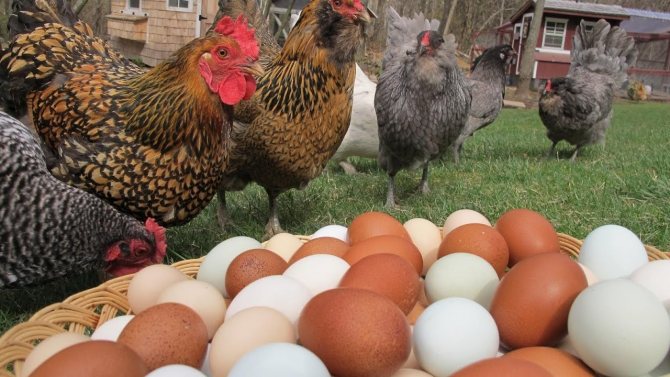

The basic rule is that domestic chickens of egg breeds must be fed at least twice a day: immediately after waking up and one hour before the lighting in the chicken coop is turned off. Moreover, all the elements important for the bird's body should be contained in each portion. Ready-made compound feed purchased on the market greatly simplifies the process. In this case, you will need to independently include only grain, vegetables and fresh herbs in the chicken diet.
In some cases, feeding can be three or four times a day. This is true for juveniles up to 48 weeks of age. It is also recommended to carry out a slight increase in portions in the cold season to obtain the required amount of energy for the chickens and protect them from hypothermia.
Feed preparation rules
Food should be weighed before serving to avoid malnutrition or overeating of birds. Any deviations from the norm negatively affect the health and egg production of chickens. It is better to fill the feeder not to the brim, but 2/3 so that the birds cannot scatter and trample the food.
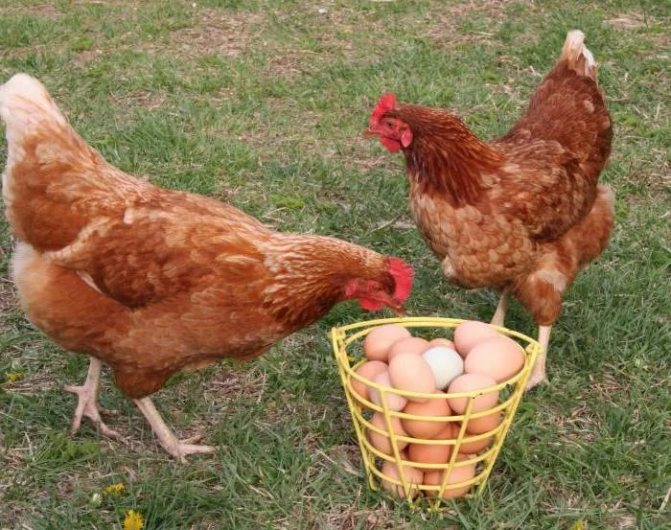

Sometimes laying hens are given a self-prepared mash. Such food must be prepared only for one meal, because it is perishable. Confirming the economy and practicality of keeping, poultry are not too whimsical in food: leftovers from the table with the addition of additional ingredients will not harm them, and an important part of the diet of chickens is made up of inexpensive vegetables, fresh grass, and plant tops.
It is important to know that fresh bread recently brought from the bakery is not suitable for adding to the feed of laying hens. Baked flour products in the stomachs of birds swell and stick together, which can lead to their death. It is permissible to use bread only in the form of rusks, ground into powder, provided that there is no mold. The content of this additive is a maximum of 30% of the total weight of the feed.
The correct daily diet for laying hens
The presence of egg-bearing grains, vegetables, fresh vegetation and mineral elements in the diet of domestic chickens contributes to the rapid laying and gaining the required body weight. To accelerate productivity, the daily menu should consist of certain components and correctly calculated proportions.
| Boiled potatoes | 100 |
| corn | 120 |
| cake | 7-8 |
| wet mash | 25 |
| bone flour | 2 |
| a piece of chalk | 3 |
| yeast | 1 |
| salt | 0,5 |
In the morning, feeding should include a wet mash with the addition of crushed egg shells, bone meal, boiled potatoes, grain, food waste from the table.
For an evening meal, it's best to use whole grains mixed with other menu items not consumed during the day. It is recommended to steam some of the grain to improve the metabolism and digestion of chickens. You should not give the birds the same grain for several days in a row, it is better to alternate it daily: today - barley, tomorrow - millet, and so on.


How to calculate portions based on body weight of a bird
Laying hens, depending on the breed and egg production, can have different weights. Accordingly, they should receive different amounts of feed. For example, an ordinary domestic chicken weighing up to two kilograms, which produces a hundred eggs per year, normally needs to eat about 125 g of feed per day. A bird weighing two kilograms will need 130 g of food. Further, for every 250 g of chicken weight, 10 g of feed is added. It is necessary to take into account the increase in egg production - for every three dozen eggs, 100 g is added.
Grass for laying hens
In the summer, you can increase the amount of fresh herbs in the diet up to 50%. This will saturate the animal body with vitamins and microelements.
What herbs do chickens like:
It is always possible to add onion feathers, parsley, amaranth to the feed (the latter has a lot of protein useful for the chicken body).
Important! Chickens can eat the grass on their own, or they can serve it along with the feed mixture. The bunches of grasses are hung, otherwise the birds trample them, which is why the quality of the feed is noticeably reduced. The chicken will choose the most suitable grass for itself, so you can safely give it weeds (of course, there should not be poisonous among them).
In winter, you can give dried herbs, needles.
Unsuitable grass
Chickens eat only the grass they need, so they try to avoid poisonous plants. It is easy for novice poultry breeders to avoid poisoning - do not give prohibited grass to birds.
Food during molting
The process during which chickens molt occurs at least once a year in an adult laying hen and more often in a younger one. As a rule, it takes place at the jumper between summer and autumn. At this moment, the organisms of all the inhabitants of the poultry farm are in a weakened state. The fact is that along with molting, avitaminosis attacks birds, one of the companions of which is a general deterioration in health.
Therefore, it is important that the breeder provides an adequate supply of vitamin-rich foods during this period. How to optimally feed chickens during molting? Here green herbs will come to the rescue - feel free to add them to the diet of layers, because they are full of a variety of useful elements that will help save chickens from serious illness.
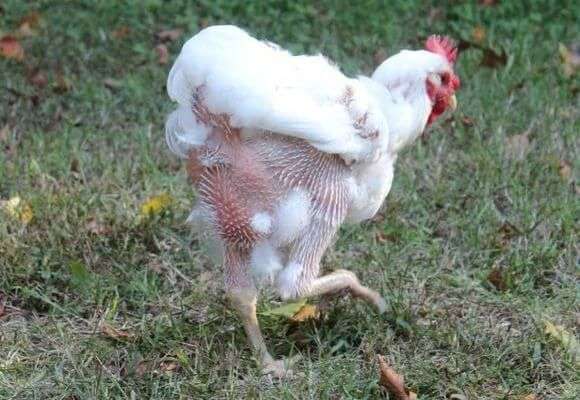

Some types of herbs
What plants are given to chickens and at what age:
- Alfalfa strengthens the body, is a source of vitamin and protein.
- Some poultry farmers are interested in whether it is possible to give the chicken euphorbia. It is a good source of vitamins and should be added to the feeder daily.
- Dandelion is rich in vitamins and contains nutrients.
- Clover contains a lot of protein.
- Horse sorrel is a source of ascorbic acid.
- Quinoa for chickens is a source of vitamins.
- In the summertime, broiler rations must be enriched with burdock.
- Some livestock enthusiasts are interested in whether it is possible to give grass to a chicken. Glum and thistle can be fed fresh or dried.
- Green mustard is used for fodder fresh or as silage.
- Wormwood is an excellent remedy for disease prevention.
- Phacelia is used for feed fresh and dried.
All these herbs are good to give from the first days of life.
Important! Celandine is a poisonous plant. But if the bird uses it a little, it will not harm her. Chickens will get sick if given buttercups. This is why not all herbs are suitable for a balanced diet.
In what form to give
Any greens (weeds, tops, sprouted wheat) must be chopped before giving to the kids.... Long leaves or stiff stems can clog the goiter or clog the stomach, blocking the esophagus and possibly death.
Leaves of edible plants are fed fresh or steamed, in winter - in the form of hay flour... Grass flour is added to the mash, as the dust clogs the chickens' nostrils and makes it difficult for them to breathe.
Sprouted grains are a very useful supplement.... Green sprouts of cereals are fed together with grains, also pre-chopped.
Harvesting feed for the winter
For poultry, it is necessary to prepare plant food for the winter. For this, waste of grain crops and residues from their processing, most types of fresh vitamin feed are suitable.
Novice poultry farmers will not have any particular difficulty in preparing the required amount of feed for the chickens. For the winter, in terms of chicken, you need to stock up on 10 kg of potatoes, the same amount of root crops (and carrots should be at least 4 kg).
Hay is harvested from young grass. It is mown before flowering or, in extreme cases, at the beginning. It should be dried in the shade, so that more vitamins are retained. Hay must be agitated, while it is necessary not to lose its valuable parts, which have the most vitamins. One chicken for the winter needs at least 3 kg of hay.
Making hay for the winter
The bird eats well grass silage, which includes alfalfa and clover, young grass, and cabbage leaves. You need to have 6 kg of such feed per head.
Birds, especially broilers, may eat quinoa. For the preparation of feed, it is advisable to mix it with other plants. Swan is dried in the form of brooms in summer, stored in ventilated rooms at low temperatures.
On a note! Chickens willingly eat duckweed. It is collected using a mesh bucket from the surface of the ponds. They give it fresh or dried. Drying is most conveniently carried out in ovens at a temperature of about 60 degrees.
Rowan berries are a valuable vitamin feed. It should be harvested in early autumn. Berries are added to combined feed.
Training your chicken to eat grass
Grass for laying hens should be in their diet from the first days of life. Usually the swarms are unpretentious to the stern. However, some birds are reluctant to eat fresh green food. Since they need vitamins for bad luck and health, the bird should be properly taught to feed, "green" it.
To train your chicken to eat green, you should add small amounts of grass for chickens to the feed for the first time. Usually, birds eat the whole portion in such a mixture. Birds can be fed with fruit. Further feeding them with green food is usually not difficult.
Feeding chickens with grass and fruits
Chickens need to chop grass, apples, pears. This will make them more willing to eat them. No bird can peck a large fruit entirely. It is more convenient if all the food for them is in a well-chopped form.
Chickens should be fed well-chopped pumpkin and carrots. This food is an excellent source of carotene. One individual should be given up to 20 g of such products.
Note! If the chicken is reluctant to eat dried grass, then it must be added to all kinds of mixtures. This significantly enriches the diet with vitamins and other useful substances.
The chicken must be walked. If this is not done, then she will be sick and suffer from vitamin deficiency and obesity. It is recommended to hang the greenery slightly so that it can move.
Compliance with the rules of correct feeding is a prerequisite for the health and egg production of poultry. The presence of green food in her diet helps to maintain their health. A sufficient amount of vitamins in food contributes to the absence of diseases in the poultry industry.
Any poultry farmer knows about the omnivorous nature of chickens. But, like any poultry, their food must be nutritious and balanced. An important part of a proper chicken diet is greens.
But not all of it is useful, so you need to know what kind of grass you can give to laying hens so as not to harm them. Greens are a natural source of vitamins and minerals that increase immunity and improve the overall health of the bird.
What else can you give to chickens?
Cereals alone cannot provide all the needs of the chicken's body, therefore, other foods must be present in its diet. Below we will consider the feasibility of introducing some of them.
Important! Before introducing any new product to poultry, its composition and information on the benefits and harms to the poultry body should be studied in detail. These data will help to correctly draw up a menu for laying hens, which will fully provide them with the necessary elements and fill all the needs of the body.
Barley
Barley is also an essential ingredient in chicken feed, as well as all farm livestock and poultry. However, it should be said that chickens do not like him because of the sharp ends of the shell. To make sure they eat it, you should give it in a mixture with other grains.
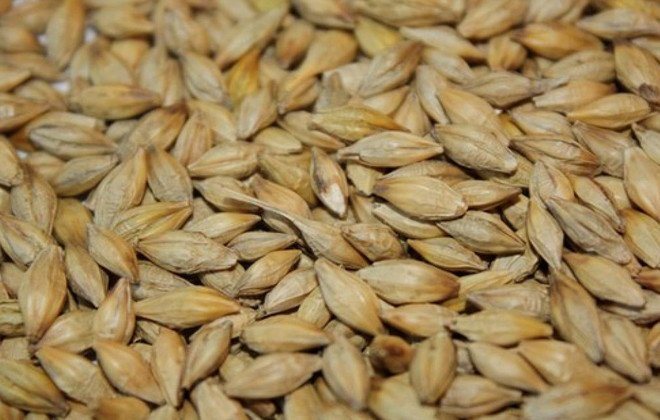

Barley, like oats, is rich in protein (10 g), carbohydrates (56 g), fats (2 g), fiber (14.5 g), vitamins, minerals, amino and fatty acids.
The optimal amount of barley in the chicken diet is 30% of the total feed per day. Young animals are fed to them, after cleaning and detailing.
It is not recommended to give this cereal during the molting period. In winter, like oats, it is advisable to feed barley in a germinated form.
Wheat
Wheat is the main grain offered to poultry: it can be fed up to 60–70% of the total feed weight. It is desirable that there is more wheat as a percentage than other grains.
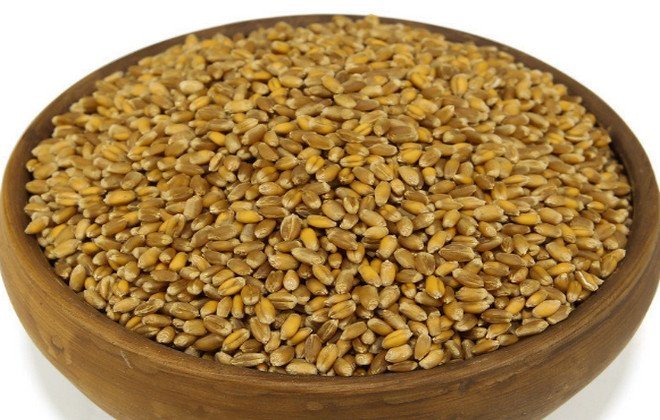

This cereal has a positive effect on the immune and hormonal systems, the development of the musculoskeletal system, joints, contributes to the development of their resistance to various diseases, and the improvement of egg production.
A bird that consumes wheat in sufficient quantities has practically no problems with the digestive tract, and there is no problem of obesity.
Important! Chickens under the age of 2 months for normal functioning, development and growth need to consume about 290 kcal, 20% protein, 4% fiber. From 2 to 4 months - 260 kcal, 15% protein, 5% fiber. After 5 months - 270 kcal, 16% protein, 5% fiber.
Like the previous cereals, it is advisable to give wheat in a germinated form. But unlike oats and barley, wheat grain is perfectly absorbed by the chicken's gastrointestinal tract, and the substances that make up it help to assimilate vitamins and minerals.
Corn
Many poultry farmers give corn to chickens without fail. This is a fairly nutritious, high-calorie (325 kcal per 100 g) and healthy product, containing 10 g of protein, 5 g of fat, 60 g of carbohydrates and 9 g of fiber.
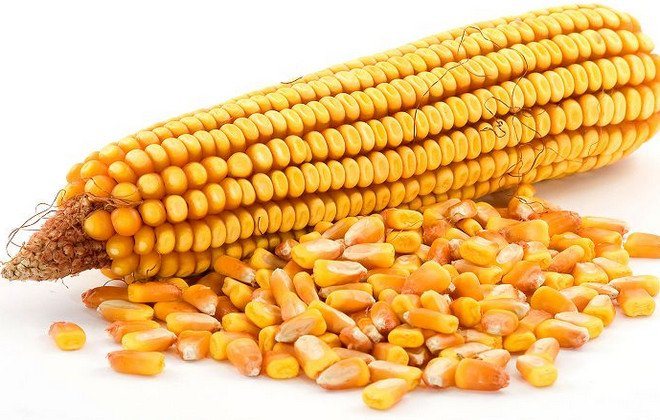

Corn is involved in the color of the yolk, increasing the productivity of the bird, its development and growth.
Corn grain should be given to chickens in ground form in dosed form, since, due to its high nutritional value, it can provoke obesity. There is a list of breeds, mainly related to the meat and egg direction, for which corn is contraindicated.
As for the amount of corn, if 120 g is recommended for laying hens per day, then 40 g of this amount should be used for corn.
Did you know? Catching chickens is a rather tedious task, and to facilitate it, a special device was invented, which in 30 seconds can catch about 200 layers, and in 60 minutes - 8 thousand. In addition to being quick, the mechanical harvesting of chickens has the advantage of reducing trauma to the paws and wings.
Bread
Whether to feed the chickens with bread is a controversial question. It can be entered in the bird menu, but not the one that remained from the common table or lay in the bread bin for several days and became moldy. Fresh, black bread and baked goods are generally prohibited for feeding.
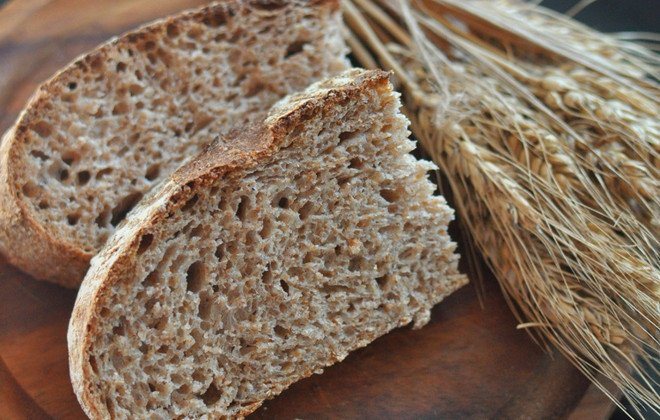

The first has a bad effect on digestion, swelling in the stomach. Brown bread contains a lot of salt and yeast, which in large quantities have a negative effect on the health of chickens. Baking is also bad for digestion.
Nevertheless, occasionally and in small quantities, this product can be mixed with potatoes, cottage cheese, bran. It should be yesterday's and dried. The substances included in its composition will help to strengthen the immunity and increase the productivity of birds. The best time for such a bait is the autumn-winter period.
A fish
To increase the productivity of egg chickens, they can be fed with boiled fish containing large amounts of phosphorus and calcium. You can pamper birds with this delicacy 1-2 times a week. It will be enough 10 g per hen per day. With more frequent feeding, there may be problems with digestion - loss of appetite, constipation.
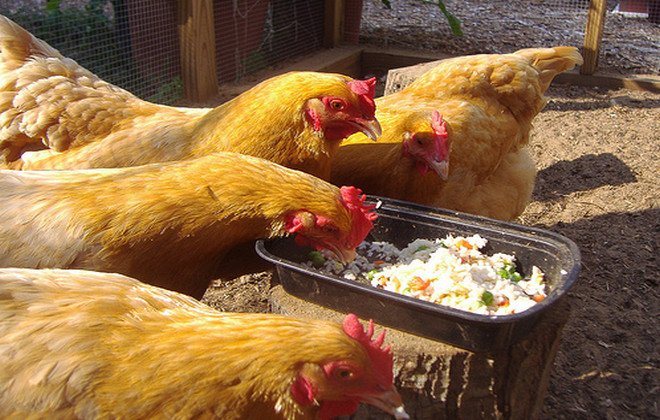

Both inexpensive fish and fish waste are suitable for feeding, which should be thoroughly grinded. It is also useful to give fishmeal: it is fed fresh in the amount of 3–12% of the total weight of the feed. There should be 1 small spoon for each hen. Flour is mixed into mixed feed or a mash.
Important! It is strictly forbidden to feed salted fish to chickens.Excessive amounts of salt lead to serious poisoning of birds, which are often fatal.
Potatoes
Potatoes are given to chickens only in boiled form, since after heat treatment, solanine, a substance harmful to birds, leaves it. It should be said that laying hens willingly eat this product - it is perfectly digested by their digestive tract and is suitable for feeding chickens from 15–20 days.
One individual can be fed up to 100 g of boiled potatoes per day. It is added to the mash, and also combined with other products.
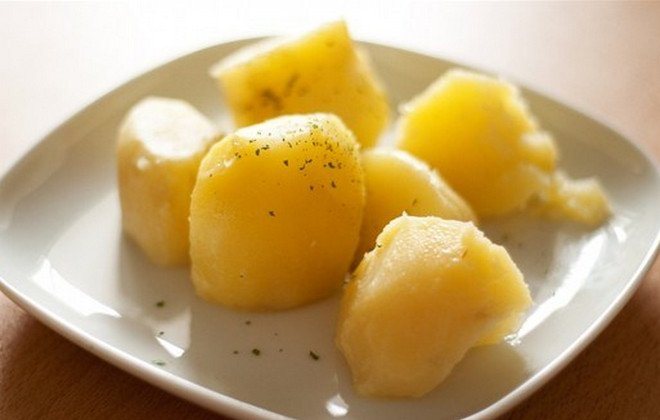

Beet
As you know, chickens need vegetables, including root vegetables. Beets can be given to chickens, however, with caution and in a strict dosage. The laxative properties of the vegetable can play a cruel joke with birds and cause profuse diarrhea, which will certainly negatively affect the general condition of the bird and egg production.
In addition, beets can stain the cloaca of a bird, and this, in turn, provokes pecking by its relatives. It is also believed that this product causes increased aggression among the chicken population.
The best type of beet to feed chickens is. It can be fed raw and cooked in crushed form. The recommended dose is 30-50 g per day per individual.
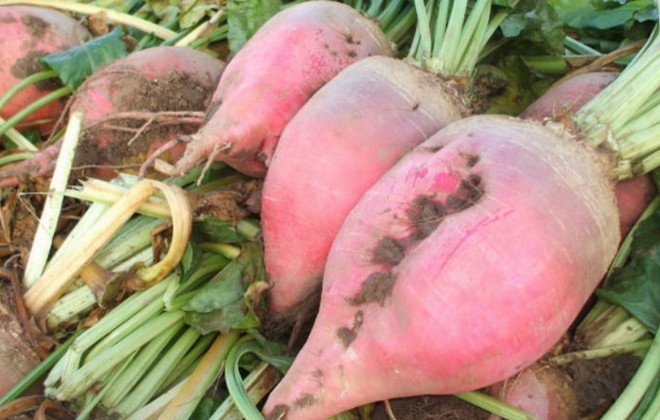

Herbs for adult layers
On average, green forage should make up 15-30% of the diet of laying hens. In the summer, when there is plenty of greenery, this figure can reach 50%. Although, the percentage of grass content depends on the composition of the diet - it should be balanced.
What grass do adult chickens like:
- dandelion;
- clover;
- nettle;
- sorrel;
- wood lice;
- spurge;
- wheatgrass;
- plantain;
- alfalfa;
- leaves of cereals.
In addition, birds are very fond of legumes, they eat hard vegetables. A good source of vitamins is cabbage, and you can feed chickens with leaves and heads of cabbage.
Beet tops, dill, parsley, onion feathers - all this chicken will eat with pleasure. Poultry farmers recommend giving birds woodlice - this is a medicinal plant that strengthens the skeleton. A good source of protein is amaranth.
The grass can be finely chopped, mixing it into the feed, or you can feed it whole. So that the chickens do not trample the greens, it is best to tie them in bunches and hang them. You can make special feeders. To do this, simply cover any suitable container with a large mesh.
Many farmers feed weeds and herbs to their chickens. If there are no harmful plants in the total mass, you don't have to worry, the birds themselves know what kind of grass they like, so they will choose the greens that they need.
In winter, the lack of fresh greens is compensated for by dried ones. Sprouted grains and pine flour are good substitutes for herbs.
Why greens are useful for laying hens
If birds graze on a walk, they know what kind of grass they like and will find it themselves. But when birds are kept in a pen and do not have access to green feed, they are deprived of many useful substances. Therefore, poultry farmers need to take care that layers always have the opportunity to nibble on fresh plants.
In summer, green forage can reach 50% of the daily ration of chickens, some poultry farmers bring this figure even higher. In addition to vitamins, greens can save a lot on the cost of purchased feed.
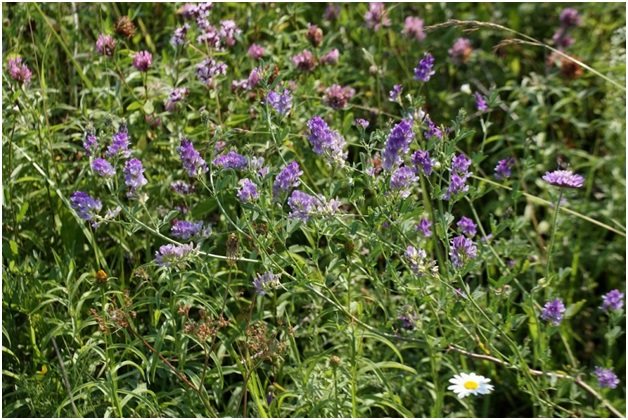

Alfalfa
The introduction of grass into the diet reduces the risk of vitamin deficiency, and increases the productivity of layers. Also, greens improve marketability (the color of the yolk is brighter and richer) and the taste of eggs, promotes good digestion in chickens.
Alfalfa is good for the vision of birds, due to its high content of vitamin A. Sprouted grains of wheat are rich in vitamin E, which increases productivity, strengthening the body of layers. Sorrel is rich in vitamin C, clover and alfalfa are rich sources of protein.
Another argument for feeding chickens with fresh herbs is the use of plants to prevent and treat certain diseases in chickens.
For example, tansy and yarrow help with worms.Vitamin D, which is contained in sprouted grains, helps against rickets.
But, not all greens are useful for laying hens, there can be poisonous plants on forbs. Therefore, when introducing green additives into the feed, you need to monitor the quality of the grass.
What greens to give chickens
As with adult chickens, young layers should be fed with fresh grass. However, it is important to know what kind of grass can be fed to chickens and how.
They begin to feed the chickens with greens from the first day after hatching. Many poultry farmers question whether it is okay to give chickens this bait so early. But in practice, finely chopped green onion feathers improve digestion and prevent intestinal diseases. But this must be done carefully - up to 5 days, the norm of greens is 1 g per chicken.
From day 5, the body becomes stronger, so this rate can be increased and diversified.
Norms of greens for chickens:
- from 0 to 5 days - 1g;
- 6 -10 - 3g:
- 11-20 - 7g;
- 21-30 - 10g;
- 31-40 - 15g;
- 41-50 - 17g.
All greens should be washed and finely chopped. For prevention, you can scald it with boiling water. You need to cook the grass just before feeding, if the greens lie for a long time after mowing, there will be few vitamins in it. They give it either by mixing with a mash, or separately.
Chickens love nettles
What grass do chickens like:
- Dandelion - rich in vitamins, has medicinal properties.
- Salad - high in minerals.
- Green onions - disease prevention, a lot of vitamins.
- Sorrel - rich in vitamin C.
- Nettle - prevention of digestion.
- Clover - contains protein.
- Plantain is a medicinal plant.
So that chicks hatched in winter do not suffer from a lack of vitamins, you can prepare plant supplies in summer. To do this, the cut grass must be tied in bunches and hung for drying.
In winter, it should be given crushed. When raising young animals, it is important to know what kind of grass the chickens like so as not to give them too much.
Complementary feeding age
Expert opinion
Novoselova Sofia Ivanovna
Farmer. 20 years of experience.
Ask a Question
They begin to feed young birds with greens as early as three days of age. In the early days, it is best to feed with nettle leaves and green onions. By the week of age, you can add dandelion leaves, radish tops. By the month, young animals can be given all edible plants.
As with any feeding, there are rules and regulations for feeding the herbal supplement to chickens.
Poisonous plants for laying hens
In order not to poison the chickens, it is imperative to inspect the place where they are walking. Usually, chickens are able to distinguish useful vegetation from harmful ones themselves, but it is better to keep this issue under control. If poisonous plants are found on grazing, they should be removed. It is best to dig up by the root - it is less likely that they will germinate again.
Harmful herb for chickens:
- broom;
- cockle;
- black nightshade;
- henbane;
- hemlock;
- horse chestnut;
- spotted hemlock;
- belladonna;
- levkoy jaundice;
- hellebore;
- elder;
- inflorescences of potatoes;
- juniper.
All these plants can provoke disease, or death of birds. Therefore, you need to keep the walking area clean, be able to identify poisonous plants and know what kind of grass hens like. Another option is not to let the hens out of the pen by adding only those ingredients to the diet that there is no doubt about the benefits.
In order for chicks to develop well and layers to be healthy and productive, their diet must necessarily include fresh herbs. In addition to the vitamin content, plants serve as a preventive measure against many diseases.
They also strengthen the immune system. But before adding green supplements to the diet, you need to know if the selected herbs can be given to chickens, and what effect to expect from them.
The benefits of greenery
Green grasses contain the nutrients chickens need for normal development and productivity:
- In addition, pecking at plants, birds absorb insects as a natural protein and mineral supplement to their diet.
- When hens are free to walk, greens make up up to 50% of the diet and allows the poultry farmer to save money spent on raising birds.
- But in winter or in conditions of continuous maintenance of individuals in a chicken coop, the poultry breeder is obliged to independently supply the wards with useful greens.
Important! Grass for laying hens is a nutritional supplement enriched with vitamins A, E and D. It serves as a natural prevention of certain diseases, such as rickets, helminthic infestation, etc.
Add only proven healthy plants to the diet of chickens, and then the layers will delight you with good health and excellent performance.

